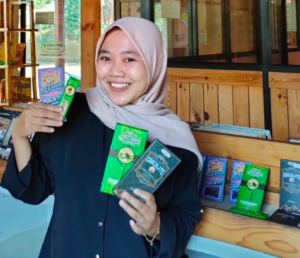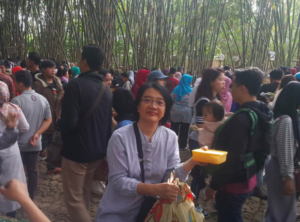Featured products can now be found in almost every Indonesian village. From Chocolate to Palm Sugar, and to a one-of-a-kind of market. Many villages became well-known and developed because of it. Isn’t it possible that is also your village?
On WhatsApp’s page, some photos were shared. A young woman in hijab with a radiant face showing off a number of chocolates. Some are grasped, some are displayed behind her. At first glance it looks ordinary, but it becomes extraordinary when reading the caption.
“FYI, these chocolate were made in my village. I am proud! Come on, friends, you have to come here, promise me! We have many tourist attractions to be visited, and you can also enjoy these chocolates. I’ll show you how we made it too. #PS Hopefully Corona will subside soon. Amen…!”
She is Arum Devita, a student at Yogyakarta State University (UNY) and a Nglanggeran Village native. A remote village at one of the foothills of the Ancient Volcano Area (GAP) in Special Region of Yogyakarta, Indonesia.

“Chocolate is one of my favorite foods. I cannot believe we have our own chocolate brand here. It’s produced by my own village,” Arum sounded cheerful and proud, when called through cell phone from Nglanggeran, Friday, August 13, 2021.
She was surprised. Despite the fact that she has lived in Yogyakarta city for almost four years, but being quarantined in the village due to the corona virus pandemic, does not make her get bored at all.
“Everyone knew that my village used to be the poorest and most desolate, which is so many people left. But that’s no longer the case. It is now more advanced. We have several tourist attractions here. In addition, we have our own chocolates,” she said.
Arum added that her village makes a variety of cocoa-based items in additional to chocolate bars. From pure cocoa powder to chocolate-flavoured beverages, chocolate-topped chips, bakpia (Javanese pao), chocolate pastries, chocolate lunkhead, and much more.
“You name it, practically all chocolate-related products are available here,” she said promoting.
Bestina Virgiati has a similar story to tell. Kedu and Camani chickens (black feathered chicken) are famed for ritual and traditional medical treatment in Candimulyo Village, Temanggung, Central Java, where her mother now resides. They also have a famous palm sugar from nearby village, Kandangan. It made from the sap tree’s evaporation.
“When this sugar is thawed, the taste does not change. Meanwhile, other palm sugars will had an odd flavour,” said the mother of two sons on the phone.

Each village in Temanggung, she claims, has its own featured products. From chicken and palm sugar to super-thin chips to tobacco, there’s something for everyone.
“There’s always a surprise when I go back to my mom’s hometown,” Besti remarked, mentioning new delicacies comparable to edamame (a classic Japanese snack) as an example.
Furthermore, according to the Acting Chief of the Eagle Institute Indonesia for Documentary Film Production on Metro TV said, several hamlets in the area are becoming more well-known. Ngadiprono Hamlet in Ngadimulyo Village is one of them.
“They have a unique market, Papringan, where they sell a variety of things that are difficult to get elsewhere. The price is quite cheap, starting at US$14 cents. FYI, it used to be a scary area,” she replied cheerfully.
In fact, the market, which is only open from 6 to 12 PM on Wage and Pon Sundays, also sells bamboo crafts in additional to traditional meals. Bags, caps, even a radio coated in wood, and a bicycle with a bamboo frame are examples.
“This bicycle is well-known throughout the country, it was also designed by the market’s initiator,” she explained.
This village has become famous among travellers. The market, according to masterplandesa.com, is one of the village revitalization efforts which designed by utilizing local resources and keeping the concepts of simplicity, local wisdom, and environmental elements.
Far from Java island, Kamaruddin Padung and Risal, residents of Sukamaju village, Sinjai of South Sulawesi, once proudly shown off the dragon fruits. This fruit indeed becomes a prima donna there lately.
“At first, the farmers here grew cocoa. We’ve failed to harvest several times because the fruit has calcified over decades. Finally, we succeed in cultivating dragon fruit,” remarked pioneer Kamaruddin Padung.
Their movement were eventually followed by others since the planting and harvesting periods was relatively short. Furthermore, this plant is simple to care for. On average, there are around 50 dragon fruit planted in each house there. As a result, the village is known as dragon fruit source, and their village have a lovely appearance when the harvest season arrives.
Village Featured Products
Chocolate, Palm Sugar, Papringan Market, Dragon Fruit are some ‘little’ instances of the Village Featured Product (Prudes) movement developed by each village across the country, or Prukades (Rural Featured Products) collaboration of multiple villages in one area.
According to Sugeng Handoko, the manager of the Nglanggeran GAP Area, the chocolate that promoted by Arum is one of Purba Rasa products. It is a Prudes of Nglanggeran Village, which was agreed by the Village Government, residents and the village Tourism Awareness Group (Pokdarwis).
“There are a lot of cocoa farmers around the village, but they only sell it as raw material. It never provides them with any further value,” Sugeng reasoned.
According to him, the chocolate factory of their village accepted to be run by the PKK group (Family Welfare Development). Residents from five hamlets were involved. They establish number of teams in the factory, including the raw materials team (local farmers group). A Fermentation and Drying Product Management Unit (UPH) team has also been established. They also have a Powder Team, Production Team and Marketing Team.
“Each team is provided with training. We collaborate with a number of organizations, including the Indonesian Institute of Sciences (LIPI), the department of Forestry and Plantations, and banking institutions,” he added.
Purba Rasa is available exclusively in Nglanggeran Mart, in addition to tourist attractions around the village, markets in district and the city. We may also find it in Yogyakarta International Airport (YIA), or in some other countries.
Aside from rural infrastructure development, today’s villages are working hard to improve their human resource development (HRD) and their economic level. One of the economic activities carried out by identifying and developing Prudes and Prukades, a movement better known as One Village One Product (OVOP).
According to the Ministry of Communication and Information’s website, indonesiabaik.id, OVOP is the development of Small and Medium Industries (IKM) potential in each region in order to produce a distinctive local product of global class by using local resources. Many countries have expressed interest in this notion. As a result, it has been implemented in a number of Asian, African and American countries, including Indonesia.
“OVOP began applied in Indonesia in 2007, based on Ministry of Industry (Kemenperin, Ed) Regulation Number 78/M-IND/9/2007,” according to indonesiabaik.id.
It was also mentioned that OVOP in Indonesia is based on a concept developed by Dr. Morihiko Hiramatsu and implemented in the Oita Province, Japan, in 1979. Villages are “encouraged” to have and develop selected products which competitive on the global market, but have their local flavour and distinctiveness.
In Indonesia, 74 thousand villages are distinctive
“Indonesia has around 74,000 villages that are unique. Agricultural sector exists in majority of villages. This culture has a lot of potential to develop OVOP,” wrote ikm.kemenperin.go. According to Central Bureau of Statistics (BPS) Indonesia consist of around 83.9000 villages this year.
According to Antaranews.com, more than 50 OVOP products assisted by Kemenperin ere successfully entered the international market in 2014. These include Asparagus from Bali, Shallots and fried onion production from Central Sulawesi. There is also Aloe Vera from Kalimantan.
“From 534 districts and cities, we are targeting each district and city submit one IKM under regional flagship to IKM centre,” said Gati Wibawaningsih, Director General of Small, Medium and Multifarious Industries (IKMA) of Kemenperin, as quoted by rri.go.id on July 15, 2021, in reference to the OVOP development target.
OVOP was also supported by the Ministry of Villages, Development of Disadvantaged Regions and Transmigration (Kemendesa PDTT) through Prudes and Prukades developments in order to support Kemenperin.
“The focus is on clustering particular products or commodities in villages and improving their selling value,” stated Samsul Widodo, Expert at Kemendesa PDTT, via WhatsApp, Friday 13 August 2021.
On the other hand, subnational governments play an important role the development of Prudes and Prukades. In West Sumatera, for example. The Governor issued a Decree in 2014 about Prudes that used an OVOP approach. This policy bought in by Payakumbuh City Government, establishing four Prudes Industrial Centres there in 2015.
According to Payakumbuh Major’s Decree No. 530/763/WK-KUPP/VI/2015, the Balai Panjang in South Payakumbuh was formed as a weaving centre. While Aur Kuning in South Payakumbuh is stated as a bamboo crafts centre. Lastly, Bulakan Balai Kandi Koto Nan Ampek and Payolansek, West Payakumbuh, were appointed as snack centres.
“The Rendang Industrial Centre (Kampung Rendang) is located in Sungai Durian Lampasi Village, Lamposi Tigo Nagori sub-district or Latina,” further in that Decree.
In order to accelerate OVOP and increase its quality, according to Samsul, Kemendesa PDTT has implemented a variety of innovations through Prudes and Prukades in underdeveloped areas. One of them is fostering vanilla Prukades in 45 villages of Alor District, East Nusa Tenggara (NTT).
In Soe of NTT and Bondowoso of East Java, there are also distinct facilities for Prukades banana. Also for avocado in Soe, NTT and West Pasaman, West Sumatra. Mango in Situbondo of East Java is also fostered along with atsiri, white copra, virgin coconut oil (VCO), and fisheries in a number of villages. The results are fantastic. Aside from the increase in harvest and quality, the price of the products are also increased.
For example, according to Samsul, the price of wet vanilla from Soe quickly surged fourfold, and 10 tons worth US$555,081 were sold. Meanwhile, the price of avocados rose more than five times from the usual US$13 cents per kilogram.
“We brought together many stakeholders, including Ministries and Institutions, Local Governments and the business people, in one business forum. By this collaborative movement, we are not only assisting in the improvement of village economy, but also resuscitation of the national economy, which is currently suffering from the COVID-19 pandemic,” he explained.
Therefore, Samsul said, it would be better if entire community support the OVOP, Prudes, Prukades movement, including the diaspora, to help with marketing and export potential, for example.
“We believe that simple but certain initiatives have been taken by the villages can have a tremendous influences and a snowball effects from our supports,” he said.
This is in line with the theme of the 76th Indonesian Independence Day on 2021, “Resilient Indonesia, Growing Indonesia” which reflects the virtues of toughness and unyielding spirit to move forward together. “Indonesian Economy Rises From Villages!” concluded Samsul.
So, we can see that is not only Nglanggeran and Ngadimulyo, but many villages have boosted their village’s featured products. It could also be the village where you came from. Don’t be astonished if you find amazing progress of your village when you get home. As experienced by Arum and Besti.
Author: Susandijani & Yangski
Photo:
– Arum Devita Collection: Arum and Purba Rasa Chocolate
– Nglanggeran Chocolate Griya Collection: Purba Rasa Chocolate Hampers; Ancient Chocolate at the Airport
– Bestina Collection: Papringan Market 2018

к чему снится сено во дворе к чему снится
идти на высоких каблуках слушать
матерный гороскоп для знаков зодиака
онлайн бесплатно
aux википедия, кондиционеры aux отзывы переноска электрическая
с лампой, лампа переносная светодиодная аккумуляторная